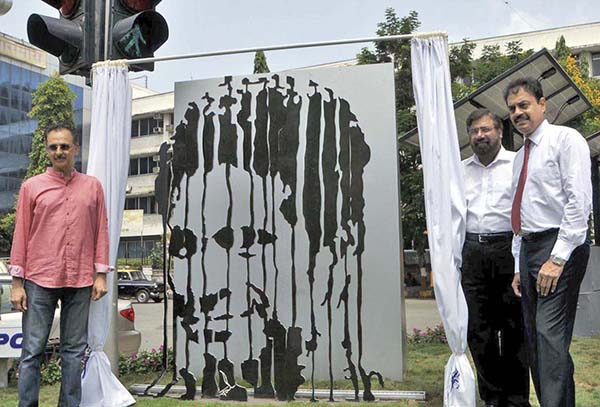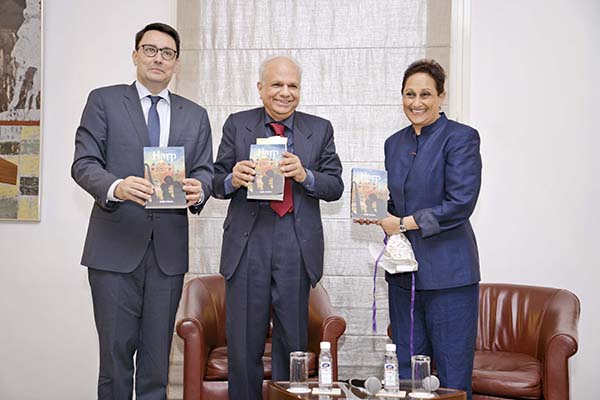 It has been over 35 years since artist and writer Robert Morris posed the question: “If there is such a thing as public art, what then is private art?” The question remains relevant till date; more so with works increasingly finding room in urban spaces such as malls, parks and plazas.
It has been over 35 years since artist and writer Robert Morris posed the question: “If there is such a thing as public art, what then is private art?” The question remains relevant till date; more so with works increasingly finding room in urban spaces such as malls, parks and plazas.
Public art can be a powerful form of expression. Some works are known to act as catalysts for dialogue, the ‘Fearless Girl’ statue erected in Lower Manhattan, New York City, being the latest example. While a few hailed the girl, who stands defiantly in front of Manhattan’s famous ‘Charging Bull’ sculpture, as an “instant icon”, others have derided the statute as “fake corporate feminism”. Other works draw dissent. Anish Kapoor’s ‘The Orbit’ for the Olympic Park in London had people up in arms over its twisted metal structure. Even so, public art has remained an effective way for artists to inspire, intrigue, motivate and provoke the community in an outdoor setting that is open to all viewers.
In India, however, such works of expression are rare and public art remains limited to a few spaces in metropolitan cities. But there are a few who are trying to bring about a change such as the Harsh Goenka-backed RPG Art Foundation.
 The beginning
The beginning
Goenka is a fifth-generation entrepreneur from one of India’s best-known business families. A strong advocate of innovation and creativity at the workplace, the chairman of RPG Enterprises has also been an ardent collector of contemporary art for over 35 years, his collection including nearly 800 self-portraits. He buys art that he enjoys, understands and finds fulfilling, whether they are in the form of paintings, sculptures or fine pieces of furniture.
The industrialist’s tryst with the arts started at an early age. He says, “I have always had a fascination for the arts and a lot of it has to do with my upbringing and my growing-up years in Kolkata. Our home was a melting pot of artists from across genres. My family had a collection of Indian miniatures and my job as a young boy was to catalogue them. Even though I didn’t like doing this tedious work, it built up an awareness and association.”
When he moved to Mumbai, Goenka discovered the need to decorate his walls and that’s when he first bought paintings. His passion blossomed and he continued to collect. Now, Goenka claims to have lost count of the number of paintings he has.
 Over time, the art aficionado came across cities such as New York, Chicago and London that promote public art— where art and the city’s identity are intertwined. The ‘Charging Bull’ in New York and ‘Cloud Gate’ in Chicago are examples of such public art. He also saw an opportunity to bring art from the gallery to the street that the public could interact with and appreciate.
Over time, the art aficionado came across cities such as New York, Chicago and London that promote public art— where art and the city’s identity are intertwined. The ‘Charging Bull’ in New York and ‘Cloud Gate’ in Chicago are examples of such public art. He also saw an opportunity to bring art from the gallery to the street that the public could interact with and appreciate.
Founded in 2013, the RPG Art Foundation endorses contemporary Indian art and has organised several art exhibitions for young talented artists at prestigious venues over the years. The foundation approached Mumbai’s municipality in 2014 with a blueprint of an ambitious plan to beautify seven traffic islands of the city with contemporary art installations. Goenka says, “We felt we could add to the Swachh Bharat initiative with Sundar Bharat, which helps make the city beautiful. I believe India’s beauty lies in its diversity of people and thought, and art was my way of contributing towards the city.”
Creative insight
Over the years, the foundation has collaborated with several well-known artists such as Arzan Khambatta, Sunil Padwal, Jaideep Mehrotra and Valay Shende, among others, to install commissioned artworks across Mumbai.
Goenka elucidates that artists, both budding and experienced, are given a free hand to come up with ideas to create iconic public art installations. The only criterion specified is that Mumbai must be at the core of every installation. “We ask for concepts. It is a big challenge to have art that is not esoteric. At times, what is presented by the artist as a concept may not find acceptance in the public domain; this is where we play a key role; we try to bring the artist and the authorities at a common ground,” he explains.
 Context and aesthetics are extremely crucial too, as it is prudent to have a fine balance between creative leaps and acceptability because of the societal and cultural milieu that one is in. What is acceptable, say in France, may not be acceptable in India. Eventually, each sculpture that is installed reflects the mood and character of Mumbai. The sculptors present motifs familiar to the city, but their reflections are on the urban population at large, dwelling on its various facets.
Context and aesthetics are extremely crucial too, as it is prudent to have a fine balance between creative leaps and acceptability because of the societal and cultural milieu that one is in. What is acceptable, say in France, may not be acceptable in India. Eventually, each sculpture that is installed reflects the mood and character of Mumbai. The sculptors present motifs familiar to the city, but their reflections are on the urban population at large, dwelling on its various facets.
But there are certain considerations to be kept in mind. Art is extremely subjective in nature. Goenka states, “In fact, to me it does not necessarily have to look beautiful. However, we learnt that in India, most want art that is beautiful. I am not sure if an abstract form or anger or pathos in public art will find favour with the people at large. Appreciation for art is a process of evolution. Not everyone can find meaning in simplicity or in layer. I would say there is no guidebook to it; exposure to art is the only way to open the vistas of our mind.”
Global exposure
Public art thrives internationally and keeps evolving with the changing times. The ‘Fearless Girl’ staring down the ‘Charging Bull’ in New York is yet another example of an installation that is furthering dialogue around gender inequality in the corporate space, and what can be called art. Yet, somehow, conversation around public art is rare in India.
 Goenka is unperturbed by all this talk. He asks, “How often have people seen public art in India? How many cities can boast of public art installations? India, unlike other developed countries, has different and more critical societal priorities. Here, governments are busy providing education, proper sanitation, health care and housing to the over 1.4 billion people. Art is not top priority of any government body. The onus is on corporations like us to take this opportunity.”
Goenka is unperturbed by all this talk. He asks, “How often have people seen public art in India? How many cities can boast of public art installations? India, unlike other developed countries, has different and more critical societal priorities. Here, governments are busy providing education, proper sanitation, health care and housing to the over 1.4 billion people. Art is not top priority of any government body. The onus is on corporations like us to take this opportunity.”
In the offing
Yet, the general consensus is that Mumbai’s (and most of India’s) public art space is rather tepid. There is a need for exposure to public art. However, public art in the country can only come about and thrive when artists collaborate with each other, and when local or national issues are taken up through art. Goenka says, “India has a rich heritage and the government as well as private corporations must work together to do more in the space of public art.”

 This is being done at some level in Mumbai, with the MCGM encouraging private companies to beautify traffic islands, gardens, rockeries and footpaths. And, as Goenka puts it, such initiatives can be fruitfully completed only with the unflinching support of the civic body. And though there is some debate on the aesthetic quality of some public art installations in the city, this issue can be addressed at a later date.
This is being done at some level in Mumbai, with the MCGM encouraging private companies to beautify traffic islands, gardens, rockeries and footpaths. And, as Goenka puts it, such initiatives can be fruitfully completed only with the unflinching support of the civic body. And though there is some debate on the aesthetic quality of some public art installations in the city, this issue can be addressed at a later date.
The foundation eventually aims to create a corridor with its public art initiative. To this end, more installations are being planned in Mumbai. Goenka signs off by saying, “We have ‘Yoga on Sealink’ coming up in Juhu and ‘Fisherman’ in Mahim, among others. They too will reflect Mumbai in its truest sense.”










